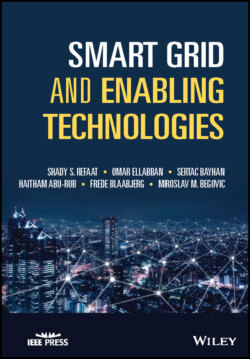Читать книгу Smart Grid and Enabling Technologies - Frede Blaabjerg - Страница 19
1.2.3 Electric Power Distribution
ОглавлениеThe distribution network is the last stage in electric power delivery responsible for carrying electricity from the transmission and sub‐transmission systems to end users. There are four main arrangements used in electric power distribution: radial, parallel feeders, ring main, and interconnected (mesh) systems as shown in Figure 1.3 [9]. Distribution networks typically have a radial topology “star network,” with merely a single power flow path between the distribution substation and a certain load (unidirectional power flow). Distribution networks rarely implement a ring or loop topology, with two power flow paths between the distribution substation and the load [10]. Moving toward renewable energy systems and introducing distributed generators (DGs) enforces the use of bidirectional power flows which causes many challenges for traditional distribution systems. A transformation to the SG paradigm includes smart elements to allow for bidirectional power flow and ES technologies. ES systems may include pumped hydro, compressed air, electrochemical batteries, flow batteries, compressed air, superconducting magnetic ES, supercapacitors, and flywheels.
Figure 1.2 Selection of rated voltage for three‐phase AC transmission line. Ref [8]. Reproduced with permission from John Wiley & Sons.
Figure 1.3 Main types used in electric power distribution, (a) Redial feeder system. (b) Ring main feeder. (c) Meshed system. (d) Parallel feeder system. Adapted from Ref Num [9].
